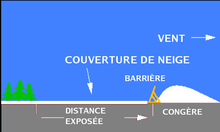Snow fence
A snow fence is a fence that, like a sand fence, forces windblown, drifting snow to accumulate in a desired place. They are primarily employed to minimize the amount of snowdrift on roadways and railways. Farmers and ranchers use snow fences to create drifts in basins for a ready supply of water in the spring.[1] Ski resorts also use snow fences in order to increase snow depth in specified areas, or for avalanche control.
Temporary snow fences are usually one of two varieties: perforated orange plastic sheeting attached to stakes at regular intervals (the type usually used for construction site fencing or temporary sports field fencing), or a cedar or other lightweight wood strip and wire fence, also attached to metal stakes. A permanent snow fence usually consists of poles with horizontal planks running across them so that they cover just over one-half of the total fence area. The bottom 10% to 15% of the fence should be left open so that snow does not settle directly under the fence, which would reduce its effective height. Taller fences trap more snow. Taking the height of the fence as one unit, it should be placed thirty-five units or more to windward of the road or building that it is meant to protect.[2] Permanent snow fences can also consist of lines of closely spaced shrubs, conifer trees or maize stalks.[3][4]

Snow fences work by causing turbulence in the wind, such that it drops much of its snow load on the lee side of the fence. Thus, snow fences actually cause snow drifts, rather than preventing them. The fences are placed so as to cause a snow drift where it is beneficial, or not harmful so that the snow does not drift onto undesired areas such as roads or among buildings.
Snow fences have been reported to save lives and reduce maintenance costs. Snow and ice removal and control costs over $2 billion annually in the US.[5] Studies published by Strategic Highway Research Program (SHRP) of National Research Council in 1991 showed that Mechanical snow removal costs about 100 times more than trapping snow with fences.
See also
- Snow guard, a device attached to roofs to prevent snow from falling on people below
- Snow shed, which is designed so that snow collects on top
References
- ↑ Jairell, R; Schmidt, R (1999), "133", Snow Management and Windbreaks (PDF), Range Beef Cow Symposium, University of Nebraska - Lincoln, p. 12
- ↑ Tabler, Ronald (October 1991). Snow Fence Guide (PDF). Washington, DC: National Research Council. p. 76.
- ↑ "Living Snow Fences: Functions and Benefits" (PDF). University of Minnesota. 2011. Retrieved 14 November 2014.
- ↑ Nixon, Wilfrid; Davison, Megan; Kochumman, George (November 2006), Living Snow Fences (PDF), University of Iowa, retrieved 14 November 2014
- ↑ Blackburn, Robert R. (2004-01-01). Snow and Ice Control: Guidelines for Materials and Methods. Transportation Research Board. ISBN 9780309087995.
External links
| Wikimedia Commons has media related to Snow fences. |
- "Effective Snow Fences" on YouTube
- Plan for a 3 meter Wyoming-style snow fence.
- Plan for a 3.6 meter Wyoming-style snow fence.
- "What’s That Thing: Roadside Fence Edition", by Mark Vanhoenacker, Slate, Aug. 1, 2013
- Snow fences: do they still serve a purpose?
- Building effective Snow Fences – Better than a good idea